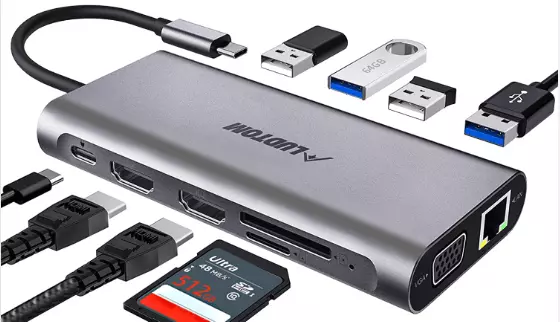Are you tired of constantly juggling between multiple devices and cables? Do you wish there was a way to simplify your work desk or home office setup?
Look no further than the USB C docking station! This versatile device can help streamline your workflow by connecting all your peripherals and devices into one central hub.
And with its compatibility across various devices, it’s time to maximize your capabilities like never before.
What is a USB C Docking Station?
A USB-C docking station is a compact device that expands your laptop’s connectivity options. It acts as a hub, allowing you to connect multiple peripherals simultaneously. Here are some key features:
Ports Galore: USB-C docks come with an array of ports, including USB-A, HDMI, DisplayPort, Ethernet, and audio jacks. Say goodbye to dongles cluttering your workspace!
Charging Power: Many docks provide power delivery (PD) capabilities, ensuring your laptop stays charged while you work.
Multi-Monitor Support: Need dual monitors? USB-C docks can handle it, offering high-resolution display options.
How to Use a USB C Docking Station
Using a USB C Docking Station is an easy and efficient way to maximize the capabilities of your device. Here are some steps to get you started:
First, connect the AC power adapter that came with your docking station. This will ensure enough power to support all of the devices connected to it.
Next, plug your USB C cable from the docking station into your computer or other compatible device. This will establish a connection between the two.
Once you have established a connection, you can connect any additional peripherals or devices, such as monitors, keyboards, mice, external hard drives, and more. Plug them into their designated ports on the dock.
USB-C Hub or Docking Station: Which Is Better for Remote Working?
With the rise of remote working, it’s essential to have a reliable and efficient way to connect your devices. USB-C hubs and docking stations provide this convenience, but which is better for remote working?
USB-C hubs are a great option if you’re looking for something portable and easy to use on the go. They can be plugged into your laptop or tablet and instantly expand their connectivity options with multiple ports such as HDMI, USB-A, SD card readers, Ethernet ports, etc.
Docking stations, on the other hand, offer more advanced features designed explicitly for workstations at home or office. They typically come with additional ports, including audio jacks and dual-monitor support, allowing you to connect multiple external displays simultaneously.
When it comes to choosing between a USB-C Hub and a Docking Station for remote working, it ultimately depends on your specific needs. If portability is the key, go for a USB-C hub, but if multi-tasking is essential, opt for a docking station instead.
Related post: If you want to know about the HD Coax Modulatoh, dive into the link to know more details.
Conclusion
To sum it up, a USB C docking station can significantly enhance the connectivity and productivity of your devices. It allows you to maximize the capabilities of your laptop or tablet by enabling multiple displays, USB ports, Ethernet connections, and other valuable features.
Whether you need to connect external monitors for work or play games on a bigger screen, a USB C docking station offers an easy and convenient solution. It simplifies cable management and reduces clutter on your desk or workstation.
FAQs About USB-C Docking Stations
Q1: Why should I use a docking station?
A: Docking stations simplify connectivity, reduce cable clutter, and enhance productivity.
Q2: Can I use a USB-C dock with my MacBook?
A: Absolutely! Look for MacBook-compatible docks for seamless integration.
Q3: How do I choose the right dock for my laptop?
A: Consider your port needs, monitor, and power delivery capabilities.
A good it is like a Swiss Army knife for your laptop—a versatile tool that adapts to your needs. So, whether you’re a road warrior or a home-office hero, invest in one that keeps you connected and productive.

